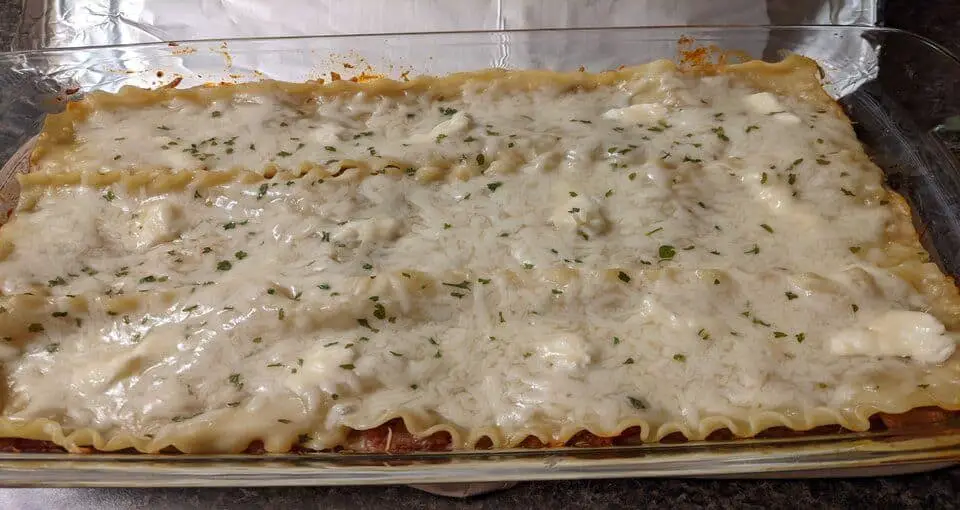Whether you are popping your lasagna in the oven for the first time or reheating some leftovers, it is crucial to quickly cover your oven-safe dish in aluminum foil, and here’s why.
Covering lasagna in aluminum foil while it bakes in the oven helps ensure that it cooks evenly, and its noodles retain sufficient levels of moisture.
Moisture retention is really the key to achieving the ideal noodle texture in lasagna. If this dish is left uncovered in the oven, especially one set at temperatures above 300 degrees Fahrenheit, you’ll likely notice that the noodles become:
- Hard
- Brittle
- Dry
- Uncharacteristically Chewy
Visually, you might not get the results you want either, as lasagna noodles tend to curl inwards when they shrivel from lack of moisture, leaving the layers disproportionate and the top looking scrunched.
- Complete Temperature Guide for Baking, Serving & Reheating Lasagna
- Chef Shows How To Make The Cheapest Homemade Lasagna
Do Most Recipes Recommend Covering Lasagna In Foil to Bake?
Lasagna is a classic Italian dish that is cherished by individuals all over the world. Thanks to its popularity, there is a significant amount of debate regarding the best way to make this dish, from ingredients to temperatures to tactics and more. One of the most common questions people ask is whether you should cover lasagna in foil when baking or if leaving it uncovered yields the best results.
Most lasagna recipes found online and in classic cookbooks recommend that the dish be covered in aluminum foil for the majority, if not the entirety, of its baking time in the oven. However, there are points when it might be best to remove the foil to achieve certain results.
In this article, we will explain why it is usually best to cover your lasagna in foil while it is baking, and when it might be beneficial to leave it uncovered. As you read, you will also learn whether baking lasagna in a foil dish is a viable option or something to be avoided.
How To Use Foil for Baking Lasagna
Before you begin baking your lasagna cover the top of the dish with aluminum foil. Remove foil halfway through baking time and finish lasagna uncovered. If you plan to bake a lasagna for 1 hour then leave the foil on for 30 minutes and then remove for the last half hour of baking.
Try not to touch to much of the cheese with the foil. As it will stick and remove your top layer of cheese.
Why You Should Let Lasagna Rest Before Baking
Let’s Say You Don’t Have Foil (Quick Fix)
In case you suddenly realized you are out of aluminum foil and your lasagna is ready to bake. Here are my quick and easy solutions.
- A Metal Pan
- Parchment Paper
Both of these can be used to cover the top of your lasagna while it bakes.
A metal baking pan, cookie sheet or even a pizza stone can be used. All you need to do is protect the top of the lasagna from direct heat for most of the baking. A square pan which covers the top of your lasagna dish.
Parchment paper as well works as an alternative to aluminum foil for covering your lasagna. Use a combination of parchment paper and a baking pan to seal the paper over top your lasagna.
When Is It Beneficial to Bake Lasagna Uncovered?
While it is highly recommended to cover your lasagna in foil when it bakes, there are instances where you might want to leave it uncovered.
The primary example would be if you want your top layer of cheese to look golden-brown, and you’re finding that it isn’t achieving this color under the foil. In this instance, you could briefly remove the foil and broil your lasagna until the cheese reaches your desired color.
If broiling isn’t an option, you could try baking it uncovered, but this increases the chances of your noodles drying and/or the lasagna burning.
Whichever method you choose, your lasagna shouldn’t need to cook uncovered for more than 20 minutes, and while it does this, you should keep a close eye on it to prevent overcooking.
Your Lasagna Is Baking but You Forgot To Cover It
If your lasagna has been in the oven for more than 30 minutes then there’s no point in covering it with foil. Just leave the lasagna in the oven and do the following.
Don’t walk away from your lasagna at this point. You want to keep an eye on the top layer of cheese.
The cheese will give you the best clue when your lasagna is done before it starts to dry out.
Look out for when the cheese starts to turn golden brown. You can also look for the edge of the noodles to make sure they are not burning.
Can You Bake Lasagna in a Foil Dish?
Another common question that is arguably even more debated in the cooking community than if you should cover your lasagna in foil, is whether this classic dish can be baked in a foil dish without negative consequences regarding safety, efficiency, and overall taste.
Cooking lasagna in a foil dish, such as those made from aluminum, is a budget-friendly and easily disposable option that does not pose a risk to consumer health and should not affect its cooking process or taste.
Many people are concerned that cooking in or near foils like aluminum will allow harmful chemicals to transfer from the metal into their food, and that ingesting these chemicals can negatively impact their health.
Sources:
https://oureverydaylife.com/lasagna-cook-faster-covered-foil-33150.html
https://www.halfscratched.com/how-long-to-bake-lasagna-at-375/
https://thewholeportion.com/can-i-cook-lasagna-in-a-foil-pan/

